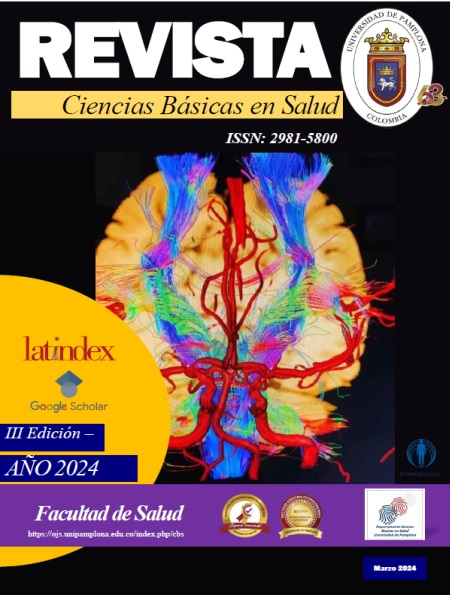Surgical management of cholangiocarcinoma: case report
DOI:
https://doi.org/10.24054/cbs.v2i1.2770Keywords:
Cholangiocarcinoma, Hepatectomy, surgery, oncologyAbstract
Introduction: Cholangiocarcinoma is a malignant tumor originating in the epithelium of the intra- or extrahepatic bile ducts, rare and represents less than 2% of malignant tumors, its incidence is 1 or 2 new cases per 100,000 inhabitants each year, the techniques of hepatectomies have evolved over time, supported by the development of surgical instruments and vascular clamping methods. Clinical case: 28-year-old female patient with a history of cholelithiasis with a space-occupying lesion at the level of the bile duct and a previous failed diagnostic procedure, who presented extrahepatic bile duct narrowing at the level of the proximal common liver, compromising the bifurcation and right hepatic origin. tumor. (Bismuth IIIa) with secondary obstruction, lymphadenopathy with a reactive appearance in the hepatic hilum, so hepatectomy was performed with the described technique. Conclusions: The surgical treatment of planned hepatectomy helps to achieve a better balance between achieving radical tumor resection of hilar cholangiocarcinoma and reasonable control of the extent of surgical damage, however it requires greater arterial reconstruction, which is technically demanding and must be performed by For experienced surgeons, the selection of the surgical strategy should be based not only on the location of the tumor (Bismuth classification) but also on vascular involvement and future liver remnant.
Downloads
References
Brody La, Brown Kt, Getrajdman Gi, Kannegieter Ls, Brown Ae, Fong Y, Blumgart Lh: Clinical factors associated with positive bile cultures during primary percutaneous biliary drainage. J Vasc Interv Radiol. 1998; 9: 572-8 DOI: https://doi.org/10.1016/S1051-0443(98)70324-0
D. Castaing, C. Salloum,Técnicas de hepatectomía por laparotomía, EMC - Técnicas Quirúrgicas - Aparato Digestivo, Volume 27, Issue 2, 2011,Pages 1-17, ISSN 1282-9129 DOI: https://doi.org/10.1016/S1282-9129(11)71062-5
Galindo F, editor. Cirugía digestiva. Buenos Aires: SACD; 2009. IV-466-, p. 1-12.
Giménez M, Andreacchio A. Carcinoma de vías biliares. Tumor de Klatskin. En:
Hann L, Greatrex K, Blumgart L y colab. Cholangiocarcinoma at the hepatic hilus: Sonographic findings. AJR 1997. 168: 985-989. DOI: https://doi.org/10.2214/ajr.168.4.9124155
Hemming AW, Reed AI, Fuiita S, Foley DP, Howard RJ. Surgical management of hilar cholangiocarcinoma. Ann Surg 2005; 241: 693-702. DOI: https://doi.org/10.1097/01.sla.0000160701.38945.82
ldberg MJ. Cholangiocarcinoma. Dis Mon. 2004; 50: 540-4. DOI: https://doi.org/10.1016/j.disamonth.2004.09.003
Jena SS, Mehta NN, Nundy S. Surgical management of hilar cholangiocarcinoma: Controversies and recommendations. Ann Hepatobiliary Pancreat Surg. 2023 Aug 31;27(3):227-240. DOI: https://doi.org/10.14701/ahbps.23-028
Klatskin, G. (1965). Adenocarcinoma of the hepatic duct at its bifurcation within the porta hepatis: an unusual tumor with distinctive clinical and pathological features. The American journal of medicine, 38(2), 241-256. DOI: https://doi.org/10.1016/0002-9343(65)90178-6
Khan SA, Thomas HC, Davidson BR, Taylor-Robin-son SD. Colangiocarcinoma. Lancet 2005; 366: 1303-14. DOI: https://doi.org/10.1016/S0140-6736(05)67530-7
Li B, Li Z, Qiu Z, Qin Y, Gao Q, Ao J, Ma W, Jiang X. Surgical treatment of hilar cholangiocarcinoma: retrospective analysis. BJS Open. 2023 May 5;7(3): zrad024. DOI: https://doi.org/10.1093/bjsopen/zrad024
Mansour JC, Aloia TA, Crane CH, Heimbach JK, Nagino M, Vauthey JN. Colangiocarcinoma hiliar: declaración de consenso de expertos. HPB (Oxford). 2015; 17 (8): 691–699. DOI: https://doi.org/10.1111/hpb.12450
Nakeeb A, Pitt HA. Radioterapia, quimioterapia y quimiorradiación en el colangiocarcinoma hiliar . HPB (Oxford). 2005; 7 (4): 278–282. DOI: https://doi.org/10.1080/13651820500373028
Passeri, M. J., Baimas-George, M. R., Sulzer, J. K., Iannitti, D. A., Martinie, J. B., Baker, E. H., ... & Vrochides, D. (2020). Prognostic impact of the Bismuth-Corlette classification: Higher rates of local unresectability in stage IIIb hilar cholangiocarcinoma. Hepatobiliary & Pancreatic Diseases International, 19(2), 157-162. DOI: https://doi.org/10.1016/j.hbpd.2020.02.001
Peña, A. M., Sánchez, A. C., Botella, E. R., & Rincón, D. (2020). Colangiocarcinoma. Medicine-Programa de Formación Médica Continuada Acreditado, 13(12), 666-677. DOI: https://doi.org/10.1016/j.med.2020.06.020
Pereira Freddy, Venales Yajaira, Salazar Francisco, Detalles técnicos de la doble anastomosis hepático-yeyuno en Y de Roux, con base en la descripción de un caso, Revista Colombiana de Cirugía, vol. 34, núm. 2, pp. 179-184, 2019, Asociación Colombiana de Cirugía. DOI: https://doi.org/10.30944/20117582.112
Rodríguez Prieto, M. D. P., & Rodríguez Medina, R. M. (2016). Tratamiento actual de las metástasis hepáticas de origen colorrectal.
Soares KC, Jarnagin WR. The Landmark Series: Hilar Cholangiocarcinoma. Ann Surg Oncol. 2021 Aug;28(8):4158-4170. DOI: https://doi.org/10.1245/s10434-021-09871-6
Sugiura T, Okamura Y, Ito T, et al. Left hepatectomy with combined resection and reconstruction of right hepatic artery for bismuth type I and II perihilar cholangiocarcinoma. World J Surg. 2019;43(3):894–901. DOI: https://doi.org/10.1007/s00268-018-4833-1
Vega P, Arribas J, González M, Moreno S, Aburto JM. Colangiocarcinoma polipoideo difuso de colédoco. CirEsp 2004; 75: 365-8. DOI: https://doi.org/10.1016/S0009-739X(04)72338-6
Xu B, Zhao W, Chang J, Yin J, Wang N, Dong Z, Zhi X, Li T, Chen Z. Comparative study on left-sided versus right-sided hepatectomy for resectable peri-hilar cholangiocarcinoma: a systematic review and meta-analysis. World J Surg Oncol. 2023 May 18;21(1):153. DOI: https://doi.org/10.1186/s12957-023-03037-2
Yalcin s, Diagnosis and management of cholangiocarcinomas: a comprehensive review. Hepatogastroenterology. 2004; 51: 43-50.
Downloads
Published
How to Cite
Issue
Section
License
Copyright (c) 2024 Revista Ciencias Básicas en Salud

This work is licensed under a Creative Commons Attribution-NonCommercial 4.0 International License.







